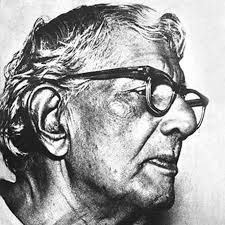Jamini Roy: 7 Powerful Insights into the Life and Legacy of a Revolutionary Indian Artist
Jamini Roy is one of India’s most celebrated and pioneering artists, whose works transformed the landscape of Indian art in the 20th century. Known for his unique blend of traditional Indian art forms with modernist influences, Roy’s art continues to inspire generations of artists and art enthusiasts alike. His journey is a testament to the power of cultural identity, creativity, and dedication to one’s craft. Let’s explore the life, works, and lasting significance of Jamini Roy.
Early Life and Education
Jamini Roy was born on April 11, 1887, in the village of Beliatore, West Bengal, India. He came from a middle-class Bengali family that valued education, which played an important role in shaping his future. Jamini Roy’s early artistic inclinations were nurtured by his family, and he eventually pursued formal training at the Government School of Art in Calcutta (now Kolkata).
Though trained in the traditional Western styles of painting, Roy’s work evolved significantly over time as he began exploring the rich cultural heritage of India. His early education exposed him to a variety of styles, but it was his exposure to Indian folk art that truly shaped his distinctive artistic voice.
Transition to Indian Folk Art and Unique Style
What sets Jamini Roy apart from many other artists of his time is his bold decision to move away from Western academic styles and embrace Indian folk and tribal art. Drawing inspiration from the art forms of rural Bengal, especially the Patachitra and Kalighat styles, Roy developed a unique visual language that combined modernist techniques with traditional themes.
One of the key influences on his art was the simple yet expressive folk art of Bengal. He rejected the heavy use of shadows and perspective typical of European art and instead focused on flat, bold color fields and simplified forms. His subjects often included everyday life, rural landscapes, animals, and religious themes—rendered with a striking, almost childlike simplicity that made his works deeply relatable to ordinary people.
His decision to draw inspiration from indigenous art forms was revolutionary during a time when modern Indian artists were predominantly following Western art movements. Jamini Roy’s return to indigenous art not only gave a fresh voice to Indian art but also helped in preserving and promoting traditional art forms that were on the brink of being forgotten.
Jamini Roy’s Iconic Works
Throughout his career, Jamini Roy produced hundreds of paintings that left a lasting impact on the Indian art world. His work evolved over time, but some of his most famous paintings include:
- “Mother and Child” – One of his most iconic and repeated motifs, this painting celebrates the bond between a mother and her child. The simplicity and purity of the image capture deep emotional resonance.
- “Village Scene” – A work that depicts rural life in India, capturing the essence of rural Bengal with its bold lines and vibrant colors.
- “Krishna and Radha” – Reflecting Roy’s religious themes, this work illustrates his interpretation of the eternal love between Krishna and Radha, done in a vibrant and distinctive style.
These pieces, among many others, have contributed to the enduring popularity of Jamini Roy’s work, establishing him as one of the foremost modern artists of India.
Daily Life and Artistic Philosophy
Jamini Roy led a humble and disciplined life. He lived simply and was not driven by commercial success or fame. His commitment to his craft was unwavering. Unlike many artists of his time who worked in studios in urban centers, Roy spent much of his life in the peaceful surroundings of his hometown in West Bengal, drawing inspiration from rural life and local traditions.
Roy’s daily life revolved around his art. He would spend hours sketching and painting, focusing on the purity of his work rather than the complexities of the outside world. His artistic philosophy emphasized simplicity, authenticity, and a deep connection with his cultural roots. Even as his work gained widespread recognition, Roy remained true to his beliefs, staying away from the commercialized art world.
Significance of Jamini Roy’s Legacy
Jamini Roy’s legacy is not just found in his iconic works, but also in his influence on subsequent generations of Indian artists. His unique blend of traditional Indian art with modernist sensibilities helped shift the focus of Indian art away from Western conventions and back to indigenous traditions. Roy’s work contributed significantly to the Indian art renaissance of the 20th century, which saw the rise of other artists who embraced India’s artistic heritage.
Roy’s ability to adapt folk traditions into contemporary forms was revolutionary. His legacy continues to inspire artists to explore their own cultural identities and to embrace their roots while experimenting with new techniques. Jamini Roy’s work resonates as a reminder of the importance of preserving cultural heritage while innovating and evolving as artists.
Facts About Jamini Roy
- Notable Recognition: Jamini Roy’s works were featured in several exhibitions, both in India and abroad. His work was even displayed at the prestigious Venice Biennale in 1954, marking a significant moment in the global recognition of Indian art.
- Awarded the Padma Bhushan: In recognition of his contributions to Indian art, Roy was awarded the Padma Bhushan, one of India’s highest civilian awards, in 1955.
- Artistic Evolution: Though his early works were influenced by European styles, Jamini Roy soon embraced folk art and painted in vibrant, flat colors with minimal detailing, creating a style uniquely his own.
- Influence on Indian Art: Jamini Roy is considered one of the pioneering figures in the modern Indian art movement and is often regarded as one of the most significant artists of the 20th century.
FAQs About Jamini Roy
1. What was Jamini Roy’s primary artistic influence?
Jamini Roy was primarily influenced by the folk and tribal art of Bengal, particularly the Patachitra and Kalighat styles. He drew upon these forms to create his own unique artistic language.
2. What makes Jamini Roy’s art unique?
Jamini Roy’s art is unique for its combination of modernist techniques with traditional Indian themes. His use of bold, flat colors and simplified forms made his work stand out as a departure from the Western academic styles that dominated Indian art at the time.
3. Was Jamini Roy’s art well-received in his time?
Yes, Jamini Roy was highly regarded during his lifetime. His works were exhibited both in India and internationally, and he received several awards, including the Padma Bhushan in 1955.
4. How did Jamini Roy impact Indian art?
Jamini Roy revolutionized Indian art by rejecting Western influences and embracing Indian folk art. His work helped revive traditional art forms and inspired subsequent generations of artists to explore and express their cultural identities.
Conclusion
Jamini Roy’s life and work have left an indelible mark on the world of art. Through his commitment to preserving and reinventing Indian folk traditions, he created a distinctive artistic style that continues to inspire and influence artists around the world. His legacy is not only in the breathtaking beauty of his paintings but also in his contribution to the larger narrative of modern Indian art. Jamini Roy’s dedication to authenticity, simplicity, and cultural expression makes him one of India’s greatest artistic icons.










